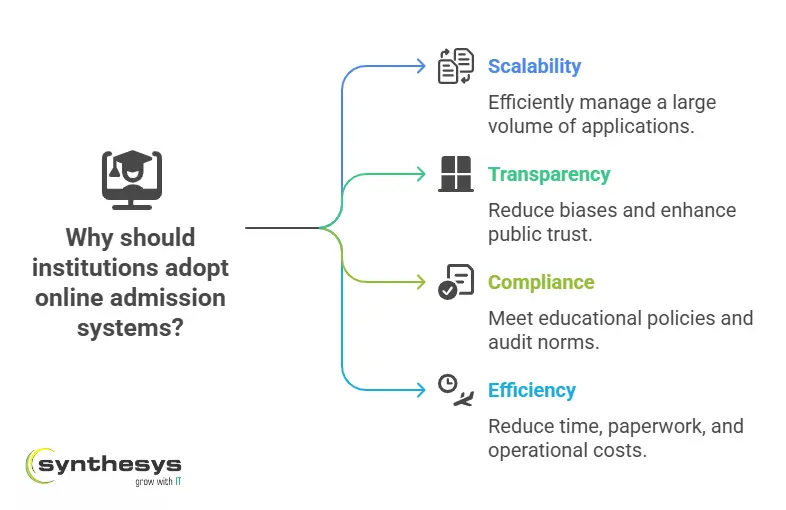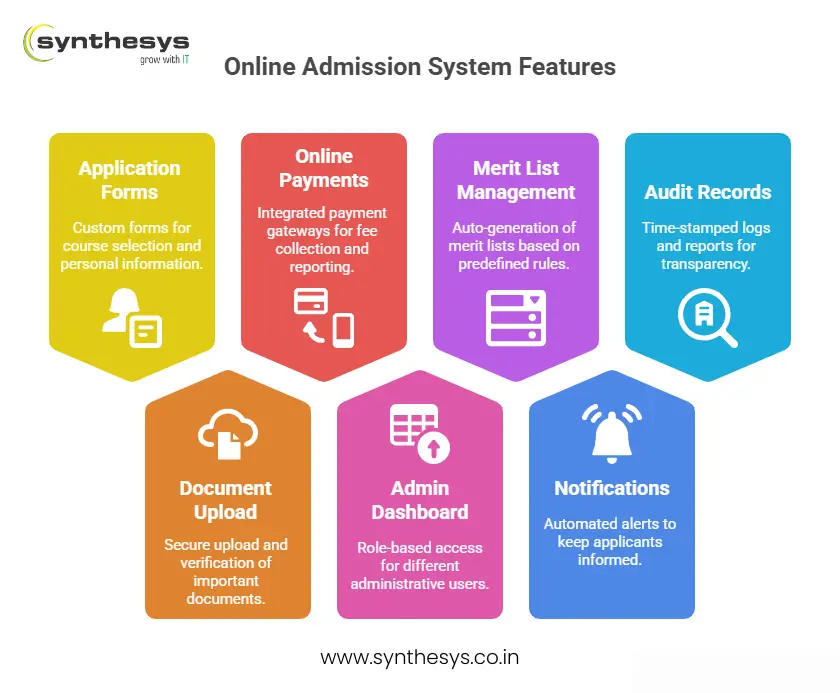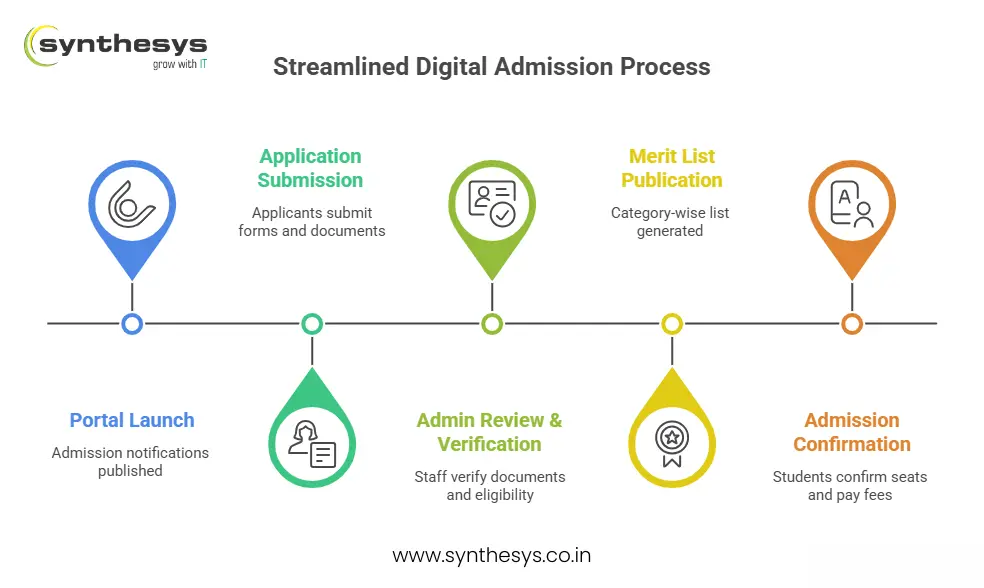The Admission Experience Is Changing Fast
Until a few years ago, admission season meant long queues, stacks of paper forms, and overworked admin teams. But with the rise of digital transformation across education and government services, a new standard is emerging: online admission systems.
These systems are now essential not just for large universities, but for smaller colleges, public education boards, and government-run scholarship schemes. They simplify complex admission workflows, improve transparency, and align with digital governance policies such as NEP 2020 and e-Governance Mission Mode Projects (MMPs).
If you’re a principal, IT officer, examination controller, or education department head wondering what these systems really do or whether they’re worth investing in this blog is for you.
What Is an Online Admission System?
An online admission system is a digital platform that automates and streamlines the end-to-end admission process for educational institutions and public sector education bodies.
It replaces manual, paper-based processes with a centralized, web-based workflow allowing applicants to apply online, and enabling institutions to manage applications, documents, fees, merit lists, and approvals in one place.
Why Are Institutions Moving to Online Admission Systems?
The shift to online admissions is driven by several practical needs:
- Scalability: Managing thousands of applications efficiently
- Transparency: Reducing biases and improving public trust
- Compliance: Meeting education policies and audit norms
- Efficiency: Reducing time, paperwork, and operational overhead

In a hybrid world where both on-campus and distance learning coexist, institutions must modernize their backend systems to meet new student expectations.
Core Features of an Online Admission System
Most online admission systems offer these core functionalities:
1. Student-Friendly Application Forms
Custom forms with course selection, reservation categories, subject preferences, and personal info.
2. Document Upload & Verification
Secure upload of certificates, ID proof, income/caste documents verified manually or via API integrations (e.g., DigiLocker).
3. Integrated Online Payments
Supports application or admission fee collection via payment gateways with receipts and reporting.
4. Admin Dashboard
Role-based access for application reviewers, program heads, admission officers, and principals.
5. Merit List & Waitlist Management
Auto-generate lists based on predefined cutoffs, weightage rules, and seat quotas.
6. Notifications & Status Updates
Automated email/SMS alerts keep applicants informed at every stage.
7. Audit-Ready Records
Time-stamped logs, exportable reports, and traceable approval flows for transparency and future audits.

How It Works: End-to-End Flow of a Digital Admission Process
Here’s a simplified version of how the system works for schools, colleges, or public education boards:
➤ Step 1: Portal Launch
Admission notifications are published on a custom portal with eligibility, deadlines, and FAQs.
➤ Step 2: Application Submission
Applicants fill out the form, upload documents, and submit online accessible on desktop and mobile.
➤ Step 3: Admin Review & Verification
Staff verify documents, flag incomplete forms, and validate eligibility using inbuilt tools.
➤ Step 4: Merit List Publication
The system generates a category-wise list based on rules (e.g., academic scores + reservation policies).
➤ Step 5: Admission Confirmation
Selected students confirm their seats, pay fees, and receive admission letters all digitally.

Benefits That Go Beyond Efficiency
Time-Saving
Cut weeks of manual sorting, printing, and in-person collection into a few days of coordinated review.
Reduced Footfall & Staff Pressure
No long queues, fewer parent visits, and less stress on admin teams during peak cycles.
Searchable, Centralized Data
Access complete admission history for audits, reporting, and academic planning.
Improved Data Security
Encrypted storage and access controls protect sensitive student records.
Anytime-Anywhere Access
Applicants from rural or remote regions can apply without needing to travel.
Use Cases: How Institutions Across India Are Adopting It
- State Education Boards managing admissions for Class XI and college intakes across districts through centralized portals
- Scholarship Authorities automating verification of thousands of financial aid applications annually
- Deemed Universities offering real-time application tracking for both domestic and international students
- Municipal Schools increasing outreach and reducing dropout risk by simplifying the entry process
These systems not only ease operations but also promote equitable access to education especially critical for government-funded programs.
Decision Factors: What to Look for in an Admission System
Before adopting a system, assess:
- Can it handle your expected applicant volume?
- Is the interface mobile-friendly and multilingual?
- Does it offer role-based access for admin teams?
- Can it generate merit lists and manage quotas easily?
- Does it follow national policies like NEP 2020, DPDP Act, and state-level education mandates?
Summary Checklist: Why It’s Worth the Shift
Here’s why education institutions and government departments are switching to online admissions:
✔ 70% faster processing of applications
✔ 90% fewer manual errors and rework
✔ Real-time data and audit-ready logs
✔ Scalable across years, courses, and campuses
✔ Easy communication with students and staff
✔ Aligned with India’s e-Governance push
Why Choose Synthesys for Your Online Admission System?
At Synthesys, we understand that each institution has its own admission rules, workflows, and compliance needs. Our custom-built online admission solutions are designed to fit your process not the other way around.
We’ve helped educational institutions, municipal departments, and exam boards:
- Digitize their entire admission cycle in under 30 days
- Integrate document verification, payments, and merit lists into a seamless flow
- Ensure security and transparency with audit trails and real-time dashboards
- Go live with multilingual, mobile-friendly portals for students across the country
Whether you need a standalone admission portal or a solution that connects with your existing ERP or website, Synthesys builds systems that work with you, not against you.
Fully customizable modules
Built for compliance and scale
Deployed securely on cloud or on-premise
Used by public institutions, schools, colleges, and education departments
Final Note: The Right Time to Modernize Is Before You’re Forced To
Online admission systems are no longer a luxury. They are the foundation of modern educational governance. Institutions that adapt early don’t just streamline operations they create a better experience for students, parents, and staff.
Need a scalable admission system tailored to your needs?
At Synthesys, we design software that adapts to your rules, scales with your volume, and aligns with your mission whether you’re a small college or a government-run education board.
Contact us today to explore a custom-built online admission system that delivers clarity, compliance, and control.
